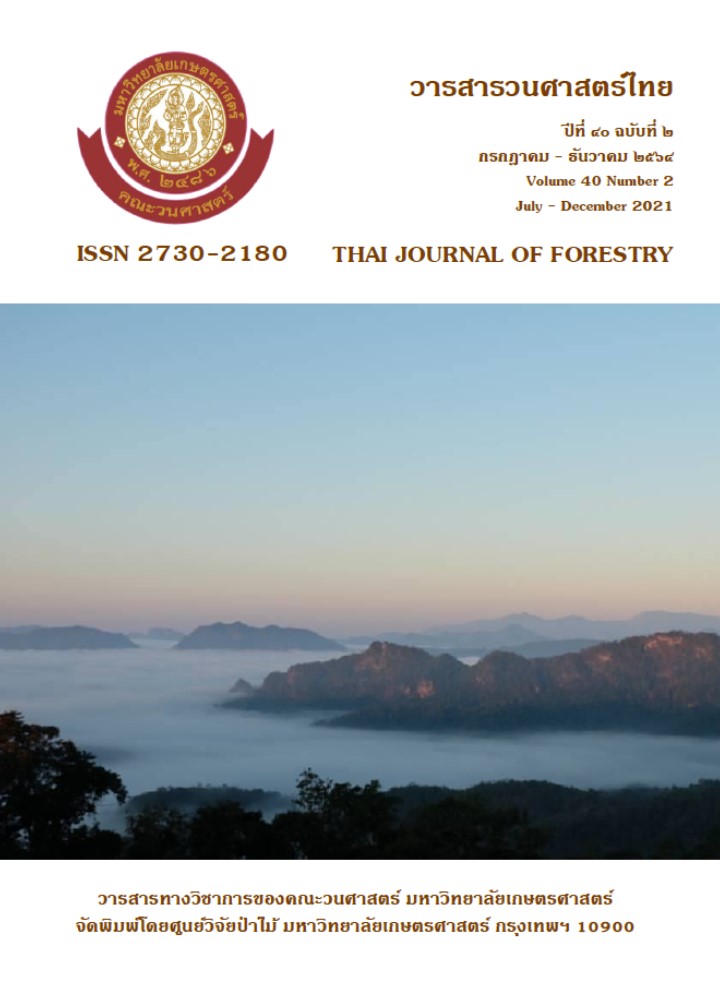เทคนิคการจำแนกการใช้ประโยชน์ที่ดิน ด้วยภาพถ่ายเชิงเลขจากอากาศยานไร้คนขับ
Main Article Content
บทคัดย่อ
อากาศยานไร้คนขับ ในปัจจุบันสามารถบินถ่ายภาพถ่ายเชิงเลขที่มีความละเอียดสูง แต่ด้วยกล้องบันทึกภาพสามารถบันทึกได้ในแถบความถี่ RGB การใช้เครื่องคอมพิวเตอร์มาช่วยในการจำแนกการใช้ประโยชน์ที่ดินต้องหาเทคนิคที่เหมาะสม การศึกษาในครั้งนี้มีวัตถุประสงค์เพื่อศึกษาเทคนิคที่เหมาะสมในการจำแนกการใช้ประโยชน์ที่ดินด้วยเทคนิคการจำแนกเชิงจุดภาพ (pixel-based classification) และเทคนิคการจำแนกเชิงวัตถุ (object-based classification) เปรียบเทียบกับการจำแนกด้วยสายตา ในบริเวณ บ้านป่าน็อต ตำบลแม่ทา อำเภอแม่ออน จังหวัดเชียงใหม่ เนื้อที่ 1,182.47 ไร่ คาบเกี่ยวเขตป่าสงวนแห่งชาติ ป่าขุนแม่ทา
ผลการศึกษา พบว่า เทคนิคการจำแนกเชิงจุดภาพ ร้อยละความถูกต้องของการจำแนกโดยรวม เท่ากับ 39.4 ค่าสัมประสิทธิ์ Kappa เท่ากับ 0.27 และ เทคนิคการจำแนกเชิงวัตถุ ร้อยละความถูกต้องของการจำแนกโดยรวม เท่ากับ 34.2 ค่าสัมประสิทธิ์ Kappa เท่ากับ 0.22 ซึ่งเทคนิคการจำแนกเชิงจุดภาพให้ค่าที่สูงกว่าเล็กน้อยแต่อยู่ในเกณฑ์การพิจารณาระดับความสอดคล้องของสัมประสิทธิ์ Kappa ระดับพอใช้ ทั้งสองเทคนิค แสดงว่าภาพถ่ายเชิงเลขจากอากาศยานไร้คนขับที่มีเพียงแถบช่วงคลื่น RGB ไม่เหมาะกับการจำแนกโดยใช้เครื่องคอมพิวเตอร์ช่วยมีความจำเป็นต้องศึกษาเทคนิคเพิ่มเติม
Downloads
Article Details

อนุญาตภายใต้เงื่อนไข Creative Commons Attribution-NonCommercial-NoDerivatives 4.0 International License.
ข้าพเจ้าและผู้เขียนร่วม (ถ้ามี) ขอรับรองว่า ต้นฉบับที่เสนอมานี้ยังไม่เคยได้รับการตีพิมพ์และไม่ได้อยู่ในระหว่างกระบวนการพิจารณาตีพิมพ์ลงในวารสารหรือสิ่งตีพิมพ์อื่นใด ข้าพเจ้าและผู้เขียนร่วม (ถ้ามี) ยอมรับหลักเกณฑ์และเงื่อนไขการพิจารณาต้นฉบับ ทั้งยินยอมให้กองบรรณาธิการมีสิทธิ์พิจารณาและตรวจแก้ต้นฉบับได้ตามที่เห็นสมควร พร้อมนี้ขอมอบลิขสิทธิ์ผลงานที่ได้รับการตีพิมพ์ให้แก่วารสารวนศาสตร์ คณะวนศาสตร์ มหาวิทยาลัยเกษตรศาสตร์ กรณีมีการฟ้องร้องเรื่องการละเมิดลิขสิทธิ์เกี่ยวกับภาพ กราฟ ข้อความส่วนใดส่วนหนึ่ง หรือ ข้อคิดเห็นที่ปรากฏในผลงาน ให้เป็นความรับผิดชอบของข้าพเจ้าและผู้เขียนร่วม (ถ้ามี) แต่เพียงฝ่ายเดียว และหากข้าพเจ้าและผู้เขียนร่วม (ถ้ามี) ประสงค์ถอนบทความในระหว่างกระบวนการพิจารณาของทางวารสาร ข้าพเจ้าและผู้เขียนร่วม (ถ้ามี) ยินดีรับผิดชอบค่าใช้จ่ายทั้งหมดที่เกิดขึ้นในกระบวนการพิจารณาบทความนั้น”


